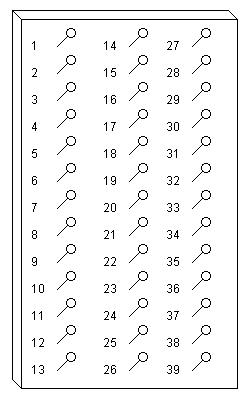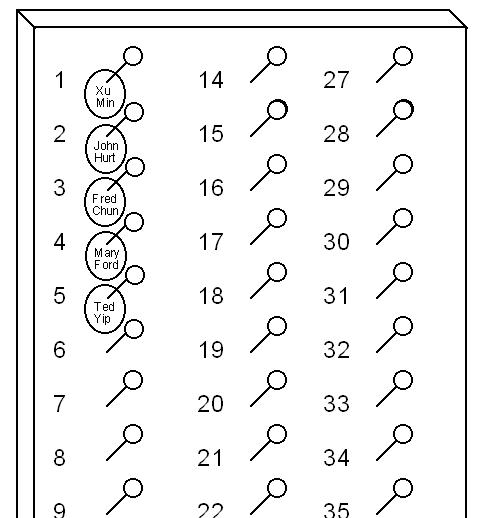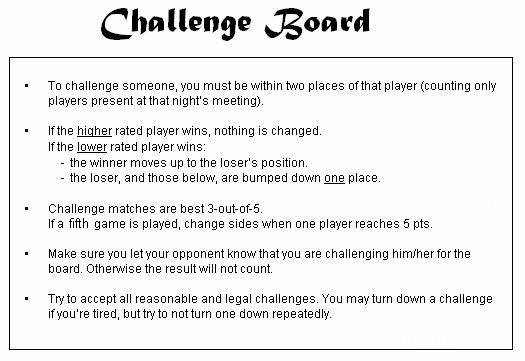The Santa Rosa System
- for running a table tennis club -
by Scott Gordon
I have long claimed that winner stays is a poor way to run
a table tennis club. Yet most clubs in the U.S. are run this way,
and people often defend it by saying that it's "easy" and that it
"runs itself". This webpage describes another system that also
is easy, runs itself, and corrects the problems that winner stays
can cause.
First off, what's wrong with "winner stays"? Well, here are some of
my complaints:
- Better players play more than weaker players
- Intimidating atmosphere
- Discourages players who want to train
- Two weak players can't choose to play against each other
- Discourages a healthy level of mixing
- Discourages stronger players from helping weaker players improve
- Discourages newcomers
It is almost impossible in a "winner stays" club for two specific people who
want to play each other, to do so. It requires one person to win on a table,
then fend off challenges until his partner gets a turn to challenge him.
Imagine the difficulty if two very weak players wanted to play against
each other (as they surely would want to)? I consider that a grossly
unacceptable feature of a club.
Others have pointed out other shortcomings. For clubs in the
United States to grow, newcomers must be retained and encouraged to
improve, not discouraged, humiliated, and made to feel like
they sit around waiting and wasting their time in an atmosphere of
nose-in-the-air people who think they're pros. And whether that is an
accurate description or not, that's exactly the atmosphere that most of
the clubs in the U.S. exhude! We need a system where the
winner does not stay.
SO... what do we do about it? Well, there are several systems that
can be employed that I believe are better. One is to use organized
round robins. In fact, that is my favorite system! HOWEVER, not
every club has the luxury of someone willing to run round robins week
after week. This webpage describes a system that doesn't require nearly
as much effort as round robins, and is also very good.
NOTE - This system is intended primarily for clubs in small-to-medium-sized
cities. I'm not sure it would work in a large metropolitan area like
New York City or Los Angeles. I'm also not sure it would work in a club
that has several rooms. Finally, it's not intended for clubs that
want to be "elite" or serving primarily very high level players.
I am calling this the "Santa Rosa" system because it is the system I used
to run the Santa Rosa Table Tennis Club for 6 years. I have since left
Santa Rosa, and so I cannot say whether they are still using the same
system. I do know that the club is still big and healthy.
Starting a Successful Club
I formed a table tennis club in Santa Rosa (California) in 1996, with
one table in a small room in a church. I was the only member.
For the first month, our meetings had between 1 and 4 attendees, but I
didn't give up. Within 3 years, we had expanded to 12 tables and
were drawing 50-70 players each meeting, two days a week
with round robins one day each week and open play on the other day.
This was in a medium-sized city that did not previously have a table
tennis club. Over half of our players were novices (less than 1000 USATT
rating), and they came week after week. How did we do it?
I did FOUR THINGS:
- affiliated with the USATT
- created a webpage
- one of our members got USATT CLUB COACHING certification
- invented a system for running the meetings (described below).
AFFLIATION
This is very important. For a nominal fee, affiliation will do most of
the advertising you will need. These days, people find table tennis clubs
by browsing the internet. Most will stumble onto the USATT webpage.
Affiliating provides them a link to your phone number, and your club's
website (which you have also created). I never advertised any other way.
Affiliation also gives you access to FREE $1M liability insurance, through
the USATT, which many facilities require before they'll let you rent space.
CREATING A WEBPAGE
Even a simple webpage is fine. At least it should have your schedule,
location, and a phone number for people with questions. We also put
our weekly club standings on it (trivial to maintain if used in conjunction
with the system described below). People love to see their name in print,
and love to be able to brag to their
friends, "I'm the #4 player in Santa Rosa!".
And, as will be shown later, the webpage not only encourages people to
come, it also encourages them to keep coming. In a way, it's
part of the system!
COACHING CERTIFICATION
None of our players were interested in giving lessons. However, having
a certified USATT coach in attendance allowed us to mention that on our
webpage, which gave us credibility. It also gave us credibility when we
went to the city looking for a bigger facility - it made us look
a lot more serious than average people expect from a "ping pong" club.
In fact, I was later able to start a table tennis class at the local
University... they weren't interested until I told them that I was
a certified USATT coach. They were shocked and impressed that there
was such a thing!
IMPLEMENTING A SYSTEM
All of the above effort is for nothing if people come and have a lousy
experience. We table tennis players sometimes pride ourselves as having
been lousy at first, but kept trying despite being humiliated, until we got
good. This doesn't work for most people. Most beginners come to clubs,
get shelacked, and leave, curiosity satiated. A good system is more
likely to make them want to come back because they had a good time, rather
than being humiliated. We need a system where the winner does not
stay. So now I will describe a system that can do all those things.
The SANTA ROSA SYSTEM
STEP 1 - Make a Challenge Board
This is easy. I recommend getting a 1'x2' piece of wood, such as a
replacement shelf from a hardware store like OSH. Put about 50 nails
in it, in 3 or 4 columns, something like 15 or 20 per column. Number
each nail (peg) 1, 2, 3, 4, etc. up to 50 (or whatever). You now have
something that looks like this:

Next, buy a box of blank pegboard disks. You can buy these in any office
supply store. For each player in the club, write their name (nicely) on a
disc with a felt-tipped pen. Put the discs on the nails in approximate
order of playing strength. Your challenge board now looks like this:

STEP 2 - Bring an 8x11 pad of paper, and a working pen.
You will need them to keep a list of the players who want to play.
Whenever a player is idle and wants to play, they add their name to
the bottom of the list. when their name comes up, they cross their
name off the list and go play.
STEP 3 - Post the Club Rules.
I printed them up on an 8x11 sheet of paper, and glued it to a stiff
cardboard backing. Each week I put the challenge board and the rules
next to each other on a display stand, next to the pad of paper.
The club then runs itself! Well, Ok - you need to know THE RULES.
here they are:
THE RULES
- When a player arrives, he adds himself to the bottom of the list
(the pad of paper).
- Each player waits his turn.
- When everyone's name above him is crossed off, it is his turn to play.
He then can choose to do one of the following:
-- ask another idle player to play for fun,
-- challenge another player for a "challenge board" match,
-- ask another idle player if they want to practice for 20 minutes,
-- delay playing (if he's still tired, or wants to wait for someone who is
already playing).
- If a player delays, it's the next player in line's turn.
- A player who is asked for a "fun" match may decline the invitation.
- All matches are 3-out-of-5.
- When a match is over, BOTH players leave the table, return to the
front, and add their names to the BOTTOM of the waiting list.
- Challenges for the challenge board work as follows:
--- you can only challenge (for the board) someone one or two spaces up
from you, counting only those players who are present.
--- for example, if you're #4, and #3 is absent, you can challenge #2 or #1.
--- if the higher player wins, there is no change to the board.
--- if the lower player wins, he moves up to the higher players spot, and
everyone in between moves down one spot (including the loser).
--- the players move the discs on the challenge board themselves (if they're
not sure sure how to do it, they can ask someone).
- A player who is asked for a "challenge" match cannot decline, unless he
has already been challenged twice that night (or once already from the
same person).
- A player who is injured does not have to accept challenges.
Notice the following:
If you don't show up, you'll gradually creep down - because people
below you will challenge people above you.
Players will need to attend regularly if they want to hold their rank.
Everyone plays equally - winning and losing have no effect on when you
play... it's first come, first served.
People can play anyone they want - they are not restricted to playing
a "winner".
People really can play anyone they want. Players quickly learn
that if they really want to play a particular person, they simply wait
their turn... then, if the person they want to play is busy, they delay
until that person is available. Thus, you can play anyone you want
as soon as you both are available and it's one person's turn.
Here is the sheet of RULES that I posted next to the Challenge Board:

There are a few more minor things that I suggest for helping newcomers
(and everyone for that matter) experience a positive, friendly atmosphere:
- When a new face walks in, SOMEONE has to meet them, welcome them, and
show them how the club works.
- I publish the Challenge Board order on the webpage every week.
- When someone fails to show up for a month, I remove their disc from
the challenge board. That way they don't creep ridiculously low on the board.
- If someone returns after a long absence, they can challenge anyone they
want to get back on the board, up to their last remembered rank.
- The first time someone comes to the club, I immediately make a disc
for them. That way they feel included right away.
- Affiliation includes a subscription to the USATT Magazine. I had a stack
of these magazines and set them out for people to read while they're waiting.
Once a month we would run a "fun" tournament, just to break things up.
Some of the events we did were: doubles tournaments, "King of the Hill",
"Brazilian Doubles", handicap, "Canadian Singles", "wrong hand", etc.
The players would often groan when I'd call the event (they tend to rebel
against change), but within 10 minutes were happily into it.
Advantages of using a challenge board, rather than ratings
- Much easier to maintain - no math
- People see the fruits of their victories immediately
- Beginners understand it immediately
- Even the worst loss only bumps you down one notch, whereas a bad
loss in a ratings system can cost 50 points and several drops in placement.
- However, a big win can jump you up a lot! Very encouraging.
- Thus, less "rating protection" - you can go up fast, but never go down fast.
Another comment about the challenge board system...
a modest first-timer may prefer to start at the bottom and work their way up.
However, some of the basement hotshots might think they are better than that,
so I let them challenge anyone they want to get on the board. However, I tell
them if they do that, then they don't actually get placed onto the board
until they beat someone. They'll probably then start scanning the room
looking for someone they think they can beat, and challenging that person.
If they lose, and/or if they look frustrated or dejected, I set their disk
on the lowest peg, and suggest them someone I think they can beat.
(usually by then one of the weak players will have already asked to play them).
AMAZINGLY ENOUGH, WITH ONLY A SMALL AMOUNT OF EXPLAINING, THIS SYSTEM
RUNS ITSELF!
p.s. - On round-robin night, we used the rankings on the challenge board
rather than ratings. If anyone is curious how we did that, I could post
that later as well.
hardbat homepage
contact: sgordon@hardbat.com